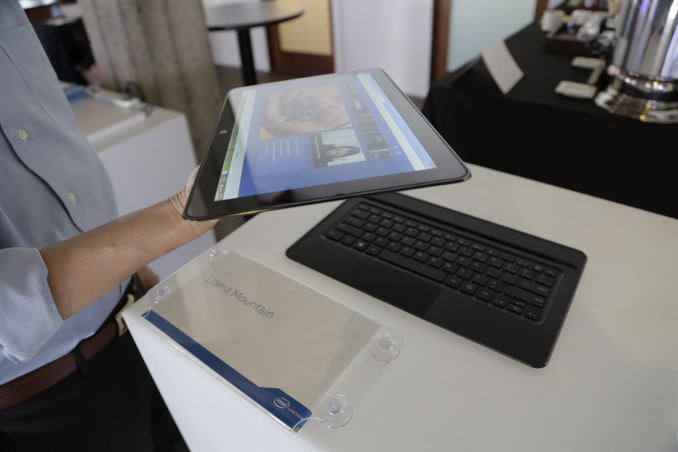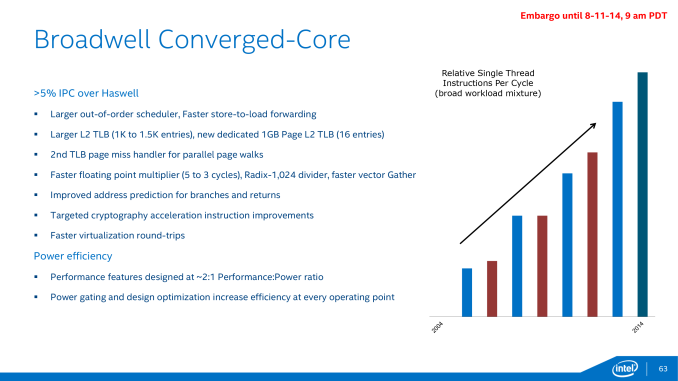Intel Broadwell Architecture Preview: A Glimpse into Core M
by Ryan Smith on August 11, 2014 12:01 PM ESTClosing Thoughts
Wrapping up our preview of the Broadwell architecture and Intel’s Core M processor, the bulk of Intel’s presentation and focus today is on the latter, so that is where we’ll start.
Core M is not a make-or-break product for Intel, but none the less it is a very important one. Mobile devices – be it tablets, slates, transformers, 2-in-1s etc – are continuing to increase in popularity, and as we’ve seen with ARM based tablets so far they form a market that has continued to grow and continued to erode the x86 laptop market that Intel has dominated for so long. Though laptops as a category are not going anywhere any time soon, their erosion means that Intel needs to get into mobile devices if they want to maintain their sales and their stature. To that end it’s not too late for Intel to break into this market and turn things around, but if they’re going to succeed then they need to make their move sooner or later, and this is where Core M fits in.
It’s telling then that while Intel is going after this market with a Core architecture, they are doing so under a different Core brand. Core M doesn’t just represent a new low powered Core CPU, but in Intel’s eyes is another product entirely. One that is so different that it does away with the Core i3/i5/i7 convention entirely and gets its own brand name and own product numbers. Core M is still Core, but it is nearly unrecognizable compared to the Core of even 4 years ago.
As far as the Core M product is concerned then, while Intel’s plans are grand they are not without merit. Backed by Intel’s new 14nm process and the Broadwell architecture, Core M looks like it should finally resolve the issues that dogged even Haswell-Y by bringing down power consumption even further while improving on Intel’s already strong performance, and getting the resulting processor in an SoC small enough to be usable in even the thinnest mobile devices. In fact from a technical perspective there’s little reason to doubt Core M; we’ll still have to wait to see just how good the resulting retail products are, but there shouldn’t be any technical reason for why it can’t be put into a mobile device comparable to today’s 10”+ tablets. Intel’s own Llama Mountain reference design can vouch for that much, showcasing the viability of Core M in a 12.5” tablet that’s just 7.2mm thick.
Intel's Llama Mountain, a Core M form factor reference design
More likely what will determine Core M’s fate and Intel’s ability to completely break into the mobile device market will be pricing. Intel’s profit margins are somewhat legendary in the computer industry, and a big part of that profitability has come from the high prices Intel has enjoyed from products such as their Core processors. Core M, like the other Cores before it, will still be an upscale product – a higher priced, higher performance alternative to Intel’s mass-market Atom processors. And while that makes plenty of sense on paper, in the real world Intel has to face the AllWinners and other ARM vendors of the world who are happy to sell their ARM SoCs at significantly lower margins, which can have a knock-on effect even if they can’t compete with Intel on overall performance. At this point it’s far too early to call this, especially when Intel isn’t even discussing Core M pricing at this time, but it’s a subject that Intel will have to consider carefully as “good enough” ARM devices will continue to be the biggest threat to Intel’s position in the CPU market.
Moving on, while today’s release from Intel only offers us a preview of what Intel will be delivering with their Broadwell architecture, what Intel has presented thus far looks to continue Intel’s tradition of relentless execution. As a tick Broadwell is a small but respectable improvement in Intel’s Core architecture, with the expected 5% IPC improvement in-line with previous ticks. For more traditional desktops and laptops it won’t radically change the world, but then it never was meant to. The biggest question for these parts will be whether Broadwell will improve on Haswell’s clockspeeds at all – a clockspeed boost made possible by Intel’s 14nm process – or if we’re going to hold steady similar to what we saw with the last tick, Ivy Bridge.
Meanwhile Broadwell’s GPU improvements are more significant, and in the race to further improve what’s essentially the baseline for PC GPU performance it is always welcome. Furthermore the fact that Intel is now at API feature parity with discrete GPUs is a big deal for Intel and it is a big deal for iGPUs as a whole. What we still want to see is more performance; a single slice seems just about right for Core M, but if we’re talking about larger laptop and desktop parts it would be very nice to see something akin to GT3 become baseline, especially with the die size savings Intel will be seeing from the 14nm process.
Finally, from here the rest of Intel’s 2014 should be rather busy. Next month is Intel’s Fall IDF 2014, at which point we expect we’ll be given a deeper look at Broadwell’s architecture. Past that the first Broadwell-Y based Core M processors will be on the shelves for the holidays, and with it our chance to see Broadwell and Intel’s 14nm process in action. However that will also be our only chance to see Broadwell in action this year; while Core M will ship in time for the holidays, the rest of the Broadwell lineup will not appear until 2015.













158 Comments
View All Comments
isa - Monday, August 11, 2014 - link
I appreciate the thoughts, but I'm actually an ASIC designer, so I have no problem with lingo - I just am not informed regarding my specific question. And my current laptop is a Penryn 2008 laptop, so forgive me if we ignore the need question and stay focused on what version(s) of Broadwell are intended for mainstream (non-gaming) desktop replacement laptops. thanks!ZeDestructor - Monday, August 11, 2014 - link
You want the full HQ/MQ series for your next laptop. Those are the full quad-core-enabled machines, which is something your probably want for a hi-performance machine. Since this is a gaming laptop though, you may want to look into building a small mini-ITX desktop though, they're comparable if your primary definition of "mobile gaming" is "drag computer to a LANparty/friend's place" rather than actually gaming on a train or similar.name99 - Tuesday, August 12, 2014 - link
If you can afford it, why are you dicking around with trying to save a few hundred dollars?If you want a serious machine, buy an rMBP with quadcore i7.
If you want a light machine, buy an MBA.
Then either stick Parallels on it (if you use OSX) or just run Boot Camp and never touch OSX, except maybe once every two months to update the firmware.
If you can afford it, life's too short to waste time trying to figure out which of fifty slightly different laptop PCs will suck less in their different hardware, different pre-installed crap-ware, different drivers. Just pay a little more and get something that most people consider works well.
ZeDestructor - Tuesday, August 12, 2014 - link
As an ASIC designer, OSX is just a non-option. Hell, even Linux is rather hairy compared to Windows for ASIC stuff.I personally like the Dell Precision line, but Lenovo Thinkpad W and HP Elitebook would also doo. In a pinch, a ridiculously-specced Compal (in it's various Sager rebrands) would also do, but IMO are just not built anywhere close.
Kjella - Monday, August 11, 2014 - link
Y = tabletsU = ultraportables
H = laptop/desktops
EP/EX = workstations/servers
So H. Out in Q2 2015, by current best guesses.
isa - Monday, August 11, 2014 - link
Thanks, Kjella. Upon further googling after reading your post, I learned that there apparently will be a mobile and deskop version of the H flavor, and it does look like the mobile H is the most likely for me. But that's not rumored to come out until May or June 2015, which is disappointing.Even weirder, since the first desktop version of Broadwell will be available in PCs in May/June 2015, and since the first version of Skylake (rumored to be a desktop version) is rumored to be "available" 2H 2015, it seems Broadwell H desktop is slated for a very, very short product life. Similarly, is Broadwell H mobile also slated for an extremely short product life?
Perhaps I missed it, but it would be great if there were an Anandtech chart comparing Intel's definitions of "announced", "launched", "samples", "volume shipments", "available", and similar Intelese to figure out about how many months from each it is till Joe Consumer can buy the chip in question. I suspect these definitions and even the lingo can vary with each tick and tock, but some kind of cheat sheet guestimates would be great (and revised as better info arrives, of course).
isa - Monday, August 11, 2014 - link
To further clarify the need for a cheat sheet, I'm familiar with the timing of tick and tock for the last few years, but it seems that 2014/2015 at a minimum will diverge so much from the last few years that previous expectations add confusion rather than clarity.ZeDestructor - Monday, August 11, 2014 - link
Judging by the delay for BW, Skylake will probably be pushed forward at least 6 months, if only to make up the R&D costs of BW. Then again, Intel wants that tablet market, so they might not either.IntelUser2000 - Wednesday, August 13, 2014 - link
"Similarly, is Broadwell H mobile also slated for an extremely short product life?"No its not. Companies like Intel cares about 5% profit differences, so having a short product life would make absolutely no sense. Broadwell isn't coming to "mainstream" desktops, only high-end enthusiast ones like the K series.
So they will all happily be a family like this:
-Skylake mainstream desktop
-Broadwell H/U/Y/K
name99 - Tuesday, August 12, 2014 - link
Semiaccurate says that quadcores (which I take to mean H-series) will not be out until 11 months from now.(Makes you wonder WTF has happened to the Skylake timeline. They haven't yet admitted that that has even slipped, let alone by how much.)